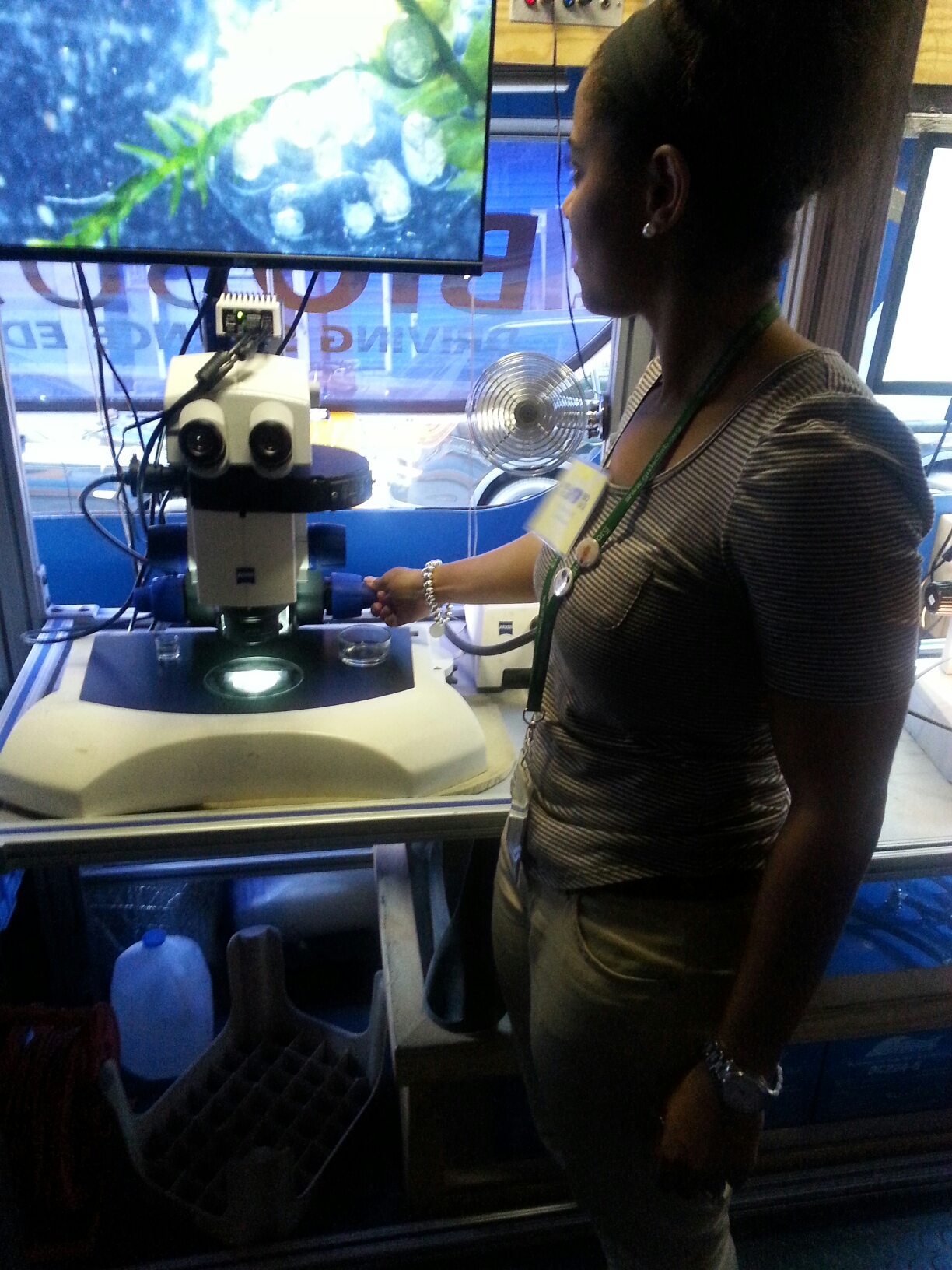Aileen Marshall

What were your science laboratory classes like when you were in grade school or high school? Did you ever get a chance to use a fluorescence microscope? Or sequence DNA? I never did. What if you had never been exposed to much laboratory science during your school years, would you have gone into the field? Probably not. This is the idea behind the BioBus. It’s a 1974 public transit bus converted into a mobile lab, with research grade microscopes. The bus’s staff and volunteer scientists travel to schools in in New York City and all over the country, particularly to underprivileged areas. Using the microscopes, they give hands on laboratory lessons in areas such as development, ecology and evolution. This gives young students a chance to actually perform a science experiment, something they might not normally have a chance to do. It spurs their interest in science and hopefully will help to develop the scientists of the next generation.
The BioBus was started in 2008 by Ben Dubin-Thaler, after getting his Ph.D. in Biology from Columbia University. The bus is retrofitted to use both solar power and biofuel. With the seats gutted, the bus has six different research grade microscopes, all with monitors, so that all the students can share their views with others. There is a light, a fluorescent, three dissecting and even an electron microscope, which only has a footprint of about two by three feet. In addition, there are two “MiScopes”, a camera probe attached to the dissecting microscopes to let the students examine their own skin, eyes, or whatever material they have. BioBus staff scientist Robert Frawley, formally of Cornell, notes “kids really like woven things since you can see the thread very clearly.” The scientists who conduct the labs are mostly volunteer, some from Rockefeller University and the other Tri-Institutions. They use fruit flies, snails, mollusks, skin cells, pollen grains and an organism called daphnia. It’s a transparent, microscopic shrimp-like organism that naturally lives in ponds and waterways in the area. It’s good for teaching anatomy since their anatomy is similar to human and visible. Under a microscope, one can see a daphnia’s heart beating and food moving through their digestive tract. The children get a chance to identify whatever organism they are working on by its DNA. The students do the pipetting to isolate the DNA and run a Polymerase Chain Reaction (PCR), which replicates the DNA in order to make it visible on an electrophoretic gel. This gel is a method of separating the DNA bases into bands in order to determine the sequence. The scientist teacher will then show them a gel that has already been run. With an onboard computer, the students compare the DNA sequence they have derived with online databases to identify their organism. The lessons typically run about forty-five minutes.
Besides the metropolitan area, the bus has been as far west as Colorado and New Mexico. Sixty-five percent of their visits are to schools in low income neighborhoods. The students are mostly African-American, Hispanic and female; groups that are underrepresented in science professions. Statistics from the BioBus show that a dramatic improvement in the students attitude towards science. The bus serves over 30,000 children a year, from grade school through high school. They have been visited by Bill Nye, “The Science Guy,” and Nobel prize winner Martin Chalfie. He won the Nobel Prize in Chemistry in 2008, for the discovery of green fluorescent protein, which is used as a marker for gene expression.
On a typical day, a scientist will meet the bus early in the morning at the first location they are visiting that day. They set up the microscopes and prepare the samples for the lessons. The first students can come on the bus at 8 a.m. Frawley relates “We have major points we want to address in our lessons, however teachers on the BioBus love to let students push the conversation with their questions and comments.” As they leave, the students get worksheets and stickers that say “Biobus Scientist.” The staff then has to clean up and set up for the next group. When the school day is done, they secure the microscopes and supplies and head back to the BioBase.
The BioBase is an extention of the Biobus opened in 2014. It is a bricks and mortar lab housed in The Girls Club on the Lower East Side. There they have after school, weekend and summer programs, too. A Regents class is offered in four one hour sessions. There is a small amphitheater for giving classes and presentations. The students will make posters from their work and present them. In the laboratory they have four dissecting scopes and two light microscopes, as well as two more MiScopes and a florescence microscope. There is some bench space, a sink, incubators, fish tanks, an under counter refrigerator, a table top centrifuge, and lab coats. In the fish tanks are organisms they collect from the East River, such as oysters and other crustaceans and many different microorganisms used in the lessons.
Most funding for the BioBus comes from private and corporate donors such as Regeneron, Lumenera and the Simmons Foundation. All of the microscopes are donated, which is equivalent to an amount in the six figures. There are plans to purchase a second bus. While there is a small staff, most of the scientists are volunteers. Rockefeller’s own Jeanne Garbarino has worked with them. For more information, go to www.biobus.org.
